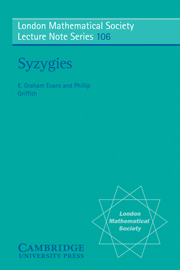Book contents
- Frontmatter
- PREFACE
- Contents
- CHAPTER 0 FOUNDATIONS
- CHAPTER 1 COUNTING DEPTHS
- CHAPTER 2 BASIC ELEMENT THEORY
- CHAPTER 3 FUNDAMENTAL THEOREMS ON SYZYGIES
- CHAPTER 4 SELECTED APPLICATIONS
- CHAPTER 5 FILTRATIONS OF MODULES BASED ON COHOMOLOGY
- CHAPTER 6 VECTOR BUNDLES ON THE PUNCTURED SPECTRUM OF A REGULAR LOCAL RING
- APPENDIX: SOME CONSTRUCTIONS OF VECTOR BUNDLES
- REFERENCES
- INDEX
PREFACE
Published online by Cambridge University Press: 05 May 2013
- Frontmatter
- PREFACE
- Contents
- CHAPTER 0 FOUNDATIONS
- CHAPTER 1 COUNTING DEPTHS
- CHAPTER 2 BASIC ELEMENT THEORY
- CHAPTER 3 FUNDAMENTAL THEOREMS ON SYZYGIES
- CHAPTER 4 SELECTED APPLICATIONS
- CHAPTER 5 FILTRATIONS OF MODULES BASED ON COHOMOLOGY
- CHAPTER 6 VECTOR BUNDLES ON THE PUNCTURED SPECTRUM OF A REGULAR LOCAL RING
- APPENDIX: SOME CONSTRUCTIONS OF VECTOR BUNDLES
- REFERENCES
- INDEX
Summary
The material in this monograph represents a collection of interrelated topics in the theory of syzygies which has occupied our thoughts since 1976. The presentation reflects our interests and prejudices. We have made no attempt to include all the many results in the theory of (finite) free resolutions. We have not tried to discuss the structure theory of finite free resolutions of Buchsbaum and Eisenbud, the highly developed theory of resolutions of determinantal ideals due to Lascoux, Buchsbaum, Akin, and others, or the behaviour of infinite resolutions which Avramov has developed. On the other hand we do describe the basic properties of syzygies starting from Hilbert's remarkable 1890 article and link this material with current problems and applications particularly in the theory of algebraic vector bundles.
Although we will deal occasionally with global rings coming from projective space (and thus graded rings and modules) or with syzygies of infinite projective dimension, our hearts and theorems lie predominantly with syzygies of finite projective dimension over local rings. As can be seen in the text, these syzygies are better behaved than general ones, and results about them do have applications to questions in commutative algebra and algebraic geometry.
We envision this monograph as a text for a special topics course following (or supplemental to) a standard one-semester course in commutative algebra. It can also serve as a handy reference for results on syzygies. We have made an effort at being self-contained by including in Chapter 0 the statements of some of the standard theorems which are important to our development but whose proof seem outside the circle of ideas that we wish to emphasize.
- Type
- Chapter
- Information
- Syzygies , pp. vii - viiiPublisher: Cambridge University PressPrint publication year: 1985



